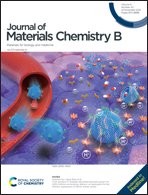Double pH-sensitive nanotheranostics of polypeptide nanoparticle encapsulated BODIPY with both NIR activated fluorescence and enhanced photodynamic therapy†
Abstract
To achieve accurate fluorescence imaging-guided cancer therapy, intelligent systems with specific responsiveness to the tumor microenvironment need to be designed. Here, we have achieved both enhanced NIR fluorescence and photodynamic therapy by introducing a dimethylamino functional group in BODIPY dyes, which can be used as a pH sensor under acidic conditions by coordinating with the proton. At pH 7.4, the fluorescence is quenched due to the photo-induced electron transfer (PET) process. After the photosensitizer is protonated in tumor cell lysosomes (pH 4.0–5.5), the PET process is inhibited and the fluorophore emission capacity is restored (fluorescence enhancement up to 10-fold), resulting in near-infrared fluorescence with the OFF/ON transition inside the tumor and enhanced singlet oxygen production for lysosome targeting capability. Due to the substitution of heavy atom iodine, the compound has a high singlet oxygen quantum yield of 81.8% in dichloromethane. In addition, using a pH-sensitive amphiphilic polypeptide (POEGMA23-PE9) as a carrier to wrap the photosensitizer BDPI can release enough drug in the acidic environment (pH 5.5–6.5) of intracellular endosomes/lysosomes, which is conducive to more adequate interactions of the photosensitizer with H+ and more effective enhancement of fluorescence emission and 1O2 production, achieving precise fluorescence imaging capability and extremely low background toxicity.



 Please wait while we load your content...
Please wait while we load your content...